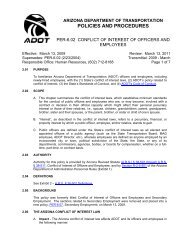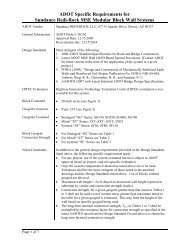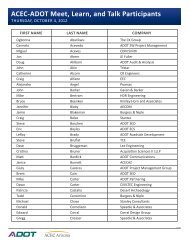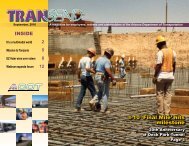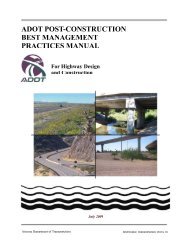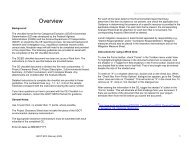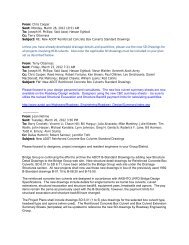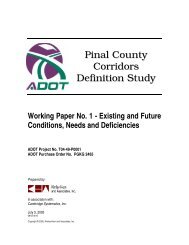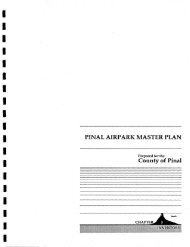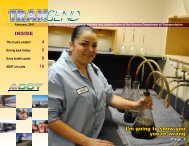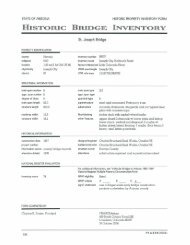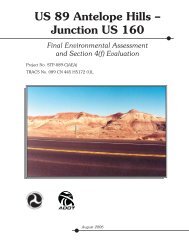I-10 Twin Peaks Traffic Interchange, Environmental Assessment
I-10 Twin Peaks Traffic Interchange, Environmental Assessment
I-10 Twin Peaks Traffic Interchange, Environmental Assessment
You also want an ePaper? Increase the reach of your titles
YUMPU automatically turns print PDFs into web optimized ePapers that Google loves.
Affected Environment and <strong>Environmental</strong> Impacts October 2005<br />
facilities to meet the National Primary Drinking Water Regulations. EPA<br />
has concurred with this finding.<br />
Biological Resources<br />
Biological resources included in this section are general vegetation and wildlife;<br />
federally endangered, threatened, proposed, and candidate species; state listed<br />
wildlife of concern; and protected native plants. Information on biological<br />
resources was obtained from a literature review, communications with local, state,<br />
and federal resource agencies, and field surveys.<br />
The study area is within the Sonoran Desert at the northern margin of the Tucson<br />
Basin. The Sonoran Desert has a warm climate characterized by low precipitation<br />
and high evapotranspiration rates. Precipitation varies considerably, but the region<br />
is generally arid. Although average precipitation in the Tucson area is more<br />
abundant than in many other parts of the Sonoran Desert, the basin receives only<br />
about 12 inches of precipitation annually. Summer rainfall (June through August)<br />
accounts for between 30 to 60 percent of the annual total, while winter<br />
precipitation accounts for <strong>10</strong> to 40 percent of the annual total.<br />
Topographic variability in the study area results in four distinct environmental<br />
zones. In the valley bottom, the Santa Cruz River floodplain and adjacent terraces<br />
support riparian and wetland vegetation, and provide a potential water source for<br />
wildlife. Creosote bush and bursage along with a variety of grasses and cacti cover<br />
the lower bajadas. Paloverde-mixed cacti communities, rich in saguaro and other<br />
cacti, grow around the mountain bases. In addition, xeroriparian vegetation<br />
communities are present along the washes radiating out of the mountains.<br />
Wildlife<br />
Existing Conditions<br />
The wildlife of the area is typical of similar sites in this region of the Sonoran<br />
Desert. The study area occurs in what is known as the ‘urban wildland interface’.<br />
The ‘urban wildland interface’ is the geographical area where urban landscapes are<br />
mixed with natural landscapes. As a result, wildlife species common to both urban<br />
and natural landscapes occur in this area. Representative common wildlife species<br />
in the study area include coyote, bobcat, javelina, desert cottontail, turkey vulture,<br />
Cooper’s hawk, red-tailed hawk, mourning dove, white-winged dove, great horned<br />
owl, Gila woodpecker, verdin, whiptail lizard, common collared lizard, and<br />
common kingsnake.<br />
Upland and riparian landscapes in the study area have the potential to provide<br />
movement corridors for wildlife. In particular, the Santa Cruz River connects core<br />
biological areas in the region of the study area including the Tortolita Mountains,<br />
Tucson Mountains, Waterman Mountains, and Santa Catalina Mountains. Wildlife<br />
species that may use the Santa Cruz River as a movement corridor include<br />
terrestrial species and avian species.<br />
Interstate <strong>10</strong> <strong>Traffic</strong> <strong>Interchange</strong> at<br />
<strong>Twin</strong> <strong>Peaks</strong>/Linda Vista<br />
4-25<br />
Project No.: NH-0<strong>10</strong>-D (AIW)<br />
TRACS No.: <strong>10</strong> PM 236 H5838 01D



